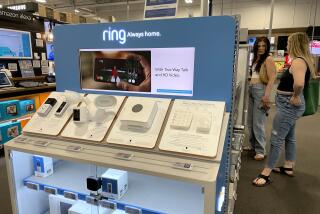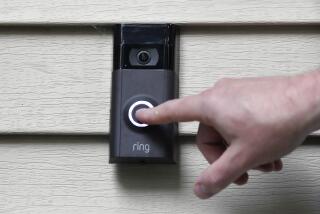The top 10 tech gadgets of 2013 [Photos]
- Share via
Wearable gadgets, smartphones and new game consoles defined technology in 2013. That’s why it’s no surprise they make up the bulk of our top 10 devices of the year.
Some of these devices are evolved versions of earlier gadgets, while others are completely new innovations that are exploring possibilities we haven’t seen before.
10. Motorola Moto X
Motorola began advertising the Moto X before it was officially unveiled, and that’s because it had exciting possibilities. The Moto X is assembled in the United States, and buyers can customize the phones to their liking.
Unfortunately, the Moto X wasn’t as customizable as most users expected. Buyers can choose the aesthetics of the device, but inside, they can pick only between having 16 or 32 gigabytes of storage. Despite these small disappointments, the Moto X is a trailblazer for customizable devices.
After the release of the Moto X, Motorola lent its support for a Phonebloks-led movement to develop customizable phones. Phonebloks is a concept crafted by a Dutch designer that calls for creating smartphones with modular parts, similar to Lego building blocks.
Motorola is working on Project Ara, which promises to one day let customers pick and choose every part of their smartphone.
The Moto X makes the list (just barely) for its inovative spirit and Motorola’s pioneering efforts.
9. LG G Flex
The LG G Flex isn’t on sale in the U.S., but it launched in South Korea this year and features a few promising new technologies that we may see on more smartphones in 2014.
For starters, the G Flex is one of two devices that went on sale this year with a curved screen. Although the curve itself doesn’t really offer much improvement when it comes to visual quality or ergonomics in my experience, the technology behind it is great news for users in terms of smartphone durability.
The G Flex uses a plastic OLED screen. That type of screen is thinner than what we see in phones today, and it is far more durable than what modern-day devices currently use. You can take the LG G Flex, whose curve runs from top to bottom, and flatten it out on a table. The device still works, and the screen doesn’t crack.
Additionally, LG covered the back of the phone with a “self-healing coating.” That doesn’t mean the device is impervious to all scratches, but users don’t have to worry much about their keys messing up the phone when in the same pocket.
The G Flex may come to the U.S. next year, but it’s still more of a concept phone. Either way, the technologies LG displayed on its curved phone are noteworthy.
8. Samsung Galaxy Gear
Pebble, a small Kickstarter project that went viral in 2012, brought smart watches to the attention of the tech world. But it Samsung that was able to introduce the technology to the masses.
In October, the South Korean tech giant released the Galaxy Gear, a watch with a small, square touchscreen capable of running apps, handling voice calls, sending text messages, taking pictures and shooting videos.
The Galaxy Gear seems like everything a spy could want, but it’s a first-generation device. That usually means there are some big flaws, and the Galaxy Gear was no exception. The device works only with select Samsung devices, it lacks any must-have apps, it’s very expensive at $299 and it’s kind of big for a watch.
Regardless of the flaws, Samsung said it had sold 800,000 units one month after the Galaxy Gear’s U.S. release.
7. Leap Motion Controller
Leap Motion wowed the world in 2012 with YouTube videos showing an extremely accurate motion sensor device for consumer laptops, and in 2013, the San Francisco start-up delivered on its promise by releasing the Leap Motion Controller.
Slightly bigger than a USB jump drive, the Leap Motion Controller enables users to control their computer with hand motions. The device can be used to simply navigate around a desktop or play games.
The Leap Motion Controller is on this list more for its technical innovation than its practical use in the home and office. If Leap Motion can roll out more useful apps, the little device could be higher up on this list in 2014.
6. Nokia Lumia 1020
The Lumia 1020 is one of the most impressive gadgets we’ve seen this year, yet it had one of the worst launches.
The Nokia smartphone has top-of-the-line specifications, including a 720p HD 4.5-inch screen and the highest-resolution smartphone camera, with 41 megapixels. The camera lets users take pictures they can then zoom in on without decreasing the quality of the image.
But the Lumia 1020 runs on the Windows Phone operating system, and when it came out this summer, the platform was still missing many popular apps. At $299 with a two-year contract when it launched, it was also a bit pricey.
Since then, the Windows Phone system has been beefed up with more apps, and the price of the Lumia 1020 has been cut. Nokia lowered the phone’s price to $199 with a two-year contract, and Windows Phone added Instagram, Vine and Waze -- three apps that had been noticeably missing.
Now, at a competitive price and with more apps available to flex the device’s camera muscles, the Lumia 1020 is one of the best smartphones you can buy if photos are a top priority.
4 (Tie). Sony Playstation 4 and Microsoft Xbox One
This year marked the first time Sony and Microsoft released new video game consoles in more than seven years. Sony came out with the Playstation 4, and Microsoft launched the Xbox One.
The two systems are fairly similar, offering 500-gigabyte hard drives in similarly styled black shells. But the two companies are taking different approaches in marketing their products.
Sony is going after the hard-core gamers, offering them the ability to easily share video of themselves playing games over the Internet by tapping a “share” button on their game controllers.
Meanwhile, Microsoft wants the Xbox One to be the center of users’ home theaters. By saying “Xbox on” followed by a command, users can control their entertainment systems with their voices. The Xbox One can also load up specific users’ profiles and preferences by detecting them with the its Kinect motion-sensor device.
For now, neither system has separated itself as the clear-cut top choice, and picking between them comes down to users’ personal preferences. The PS4 retails for $399.99 while the Xbox One goes for $499.99, but good luck finding either one. At many stores they’re back ordered.
3. Google Chromecast
Chromecast is a digital TV receiver that functions much like Roku and the Apple TV, but at a far lower price and in a much smaller package. The $35 Chromecast plugs into the TV’s HDMI outlet and streams content from users’ smartphones, tablets, laptops and computers with Wi-Fi connection.
When it launched, Chromecast worked only with Netflix, YouTube and other Google services. Since then it has been updated to also work with HBO Go, Pandora, Hulu Plus and other online subscription services.
If you’re looking for a reliable, low-cost digital TV receiver, look no further than Chromecast.
2. Apple iPad Air
Apple has been noticeably absent on this list until now, and that’s because it didn’t really innovate in 2013. Instead it focused on evolutionary improvements, most of which were marginal -- but not when it came to the fifth-generation iPad.
The Cupertino, Calif., tech giant released the iPad Air -- a thinner, lighter, sleeker version of its popular tablet -- in November. The $499 iPad Air is 0.29 of an inch thick and weighs exactly 1 pound. It’s also outfitted with Apple’s speedy new A7 64-bit chip, making it perfect for gaming.
The iPad Air was an impressive redesign to an already innovative product.
1. Google Glass
Glass has yet to be released to the public, but no other device has had as much public attention as Google’s high-tech eyewear.
The pioneering smartglasses are the most expensive item on our list -- at $1,500 a pair -- and Google sold them to a few thousand early users, most of whom seem to have fallen under the device’s spell.
Like smartwatches, Glass connects to users’ smartphones to perform tasks like playing music, sending messages and making phone calls. Glass can also shoot pictures and record video.
But 2013 was just the warmup. Glass is expected to be released to the general public in 2014, and if Google can find the right price and a better design, it may have a huge consumer hit on its hands.
ALSO:
Justin Bieber rules Instagram with most liked photo of 2013
IPhone still king: 5s the top-selling smartphone at U.S. carriers
IPad baby seat inspires campaign to stop the parenting apocalypse







